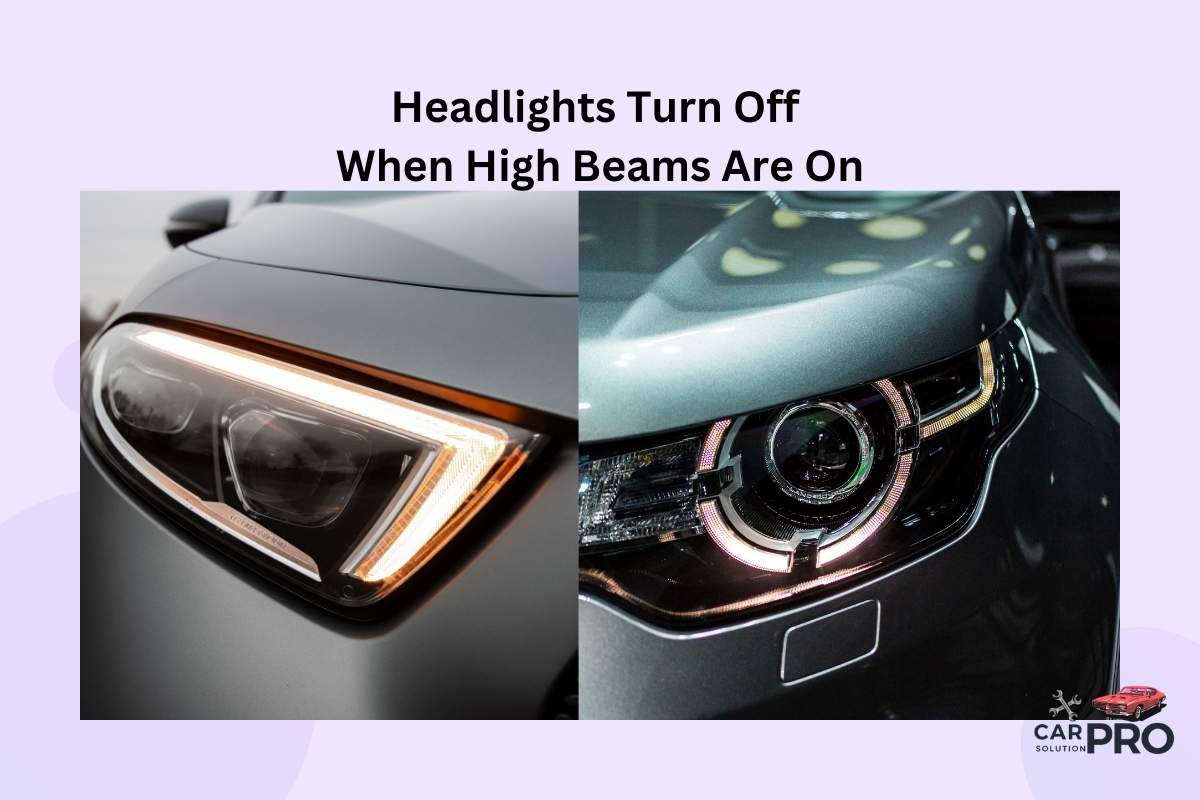Car owners may find it puzzling when their headlights turn off after switching on the high beams. This issue can be frustrating and dangerous, especially when driving at night or in low-visibility conditions. The main reason headlights turn off when high beams are activated is often due to faulty wiring or a loose connection.
The headlight system in a car is complex, involving various components working together. When a driver turns on the high beams, power is sent through a dimmer switch, which then directs electricity to the appropriate bulbs. If there’s a problem in this system, it can cause unexpected behavior like headlights shutting off completely.
Fixing this problem usually requires a thorough inspection of the headlight wiring and components. It’s important to address the issue promptly to ensure safe driving conditions. Regular maintenance can help prevent such problems from occurring in the first place.
Key Takeaways
- Faulty wiring is often the cause of headlights turning off when high beams are activated
- The dimmer switch plays a key role in controlling headlight function
- Regular maintenance can prevent unexpected headlight issues
Understanding Headlight Systems
Headlight systems are crucial for safe driving at night. They include various components that work together to illuminate the road ahead.
Components and Functions
Modern headlight systems have several key parts. The bulb produces light. Reflectors direct the light forward. Lenses focus and shape the light beam. A housing protects these components.
The low beam setting provides close-range illumination. It lights up the road without blinding other drivers. High beams offer longer-range visibility for dark, empty roads.
Many cars now have automatic systems. These can switch between low and high beams as needed. They use sensors to detect oncoming traffic or well-lit areas.
Types of Headlights
There are three main types of headlights used in vehicles today:
-
Halogen: These use a tungsten filament in halogen gas. They’re affordable but less efficient.
-
HID (High-Intensity Discharge): These produce light through an electric arc. They’re brighter and last longer than halogens.
-
LED (Light-Emitting Diode): These are energy-efficient and long-lasting. They can be shaped into sleek designs.
Some high-end cars use adaptive headlights. These can pivot to illuminate curves. They may also adjust beam patterns based on speed and road conditions.
High Beam and Low Beam Features
Car headlights have two main settings: high beams and low beams. These features serve different purposes and are used in various driving conditions.
High Beam Operation
High beams provide bright, far-reaching light. They illuminate more of the road ahead. High beams should be used on dark, open roads with no oncoming traffic.
Drivers must be careful when using high beams. They should turn them off when approaching other vehicles. This prevents blinding other drivers.
High beams can cause glare in fog or heavy snow. In these conditions, low beams work better.
Switching Between Beams
Most cars have a lever or switch to change between high and low beams. Some newer vehicles can switch automatically.
To switch manually, drivers typically pull or push the turn signal lever. In some cars, there’s a separate foot switch.
When switching to high beams, low beams may turn off. This depends on the car’s design. Some vehicles keep both on for maximum visibility.
Drivers should practice switching beams in a safe area. This helps them do it quickly when needed.
Common Issues With Headlight Function
Headlight problems can stem from various sources, ranging from simple electrical issues to component failures. Understanding these common issues helps drivers troubleshoot and address headlight malfunctions effectively.
Electrical Problems
Defective wiring or loose connections often cause headlight issues. Loose wires can disrupt the flow of electricity, leading to flickering or non-functioning lights. Corrosion on battery terminals or connectors may also interfere with power delivery.
Voltage problems can affect headlight performance. Low voltage might cause dim lights or prevent them from turning on. In some cases, headlights may randomly turn off while driving due to voltage fluctuations.
Blown fuses are another common electrical issue. When a fuse blows, it cuts off power to the headlights. Drivers should check and replace faulty fuses as needed.
Headlight Relay Failures
Relays act as switches that control power to the headlights. When a relay fails, it can cause various problems with headlight function.
A bad headlight relay often results in headlights not working at all. The relay typically fails in the open position, preventing voltage from reaching the lights.
Relay failures can affect specific headlight functions. For example, if the low beam relay fails, only the low beams won’t work. Similarly, a faulty high beam relay will only impact high beam function.
Intermittent headlight operation may also indicate a failing relay. Headlights might work sometimes but not others, or flicker on and off unpredictably.
Faulty Headlight Switch
The headlight switch controls which lights are active. A faulty switch can cause various headlight malfunctions.
Sometimes, headlights won’t turn off due to a stuck or damaged switch. This can drain the battery if left unchecked.
Worn-out switches may cause intermittent headlight operation. Lights might flicker or work inconsistently when the switch is engaged.
In some cases, a faulty switch prevents certain headlight functions from working. For instance, drivers might be unable to switch between low and high beams.
Electrical contacts inside the switch can corrode over time. This corrosion interferes with proper switch function, leading to unreliable headlight operation.
Troubleshooting and Diagnostics
When headlights turn off with high beams on, quick troubleshooting can often pinpoint the issue. Proper diagnosis is key to fixing the problem effectively.
Diagnostic Steps
Start by checking the headlight fuses and relays. Pull them out and inspect for any signs of damage or burning. Replace if needed.
Next, examine the wiring connections. Loose or damaged wires can cause intermittent headlight issues. Ensure all connections are tight and corrosion-free.
Test the headlight switch. Turn it to different positions and listen for unusual sounds. A faulty switch may not properly control the headlight functions.
Lastly, inspect the bulbs themselves. Sometimes, a failing bulb can cause unexpected behavior. Replace any dim or flickering bulbs.
Professional Diagnosis
If DIY steps don’t solve the issue, seek professional help. A mechanic can perform advanced diagnostics using specialized tools.
They may check the car’s computer system for any error codes related to the lighting system. This can reveal issues with the body control module or other electronic components.
Professionals can also conduct a thorough electrical system test. This helps identify any voltage drops or circuit problems that might be affecting the headlights.
In some cases, the mechanic might need to test the headlight relay by swapping it with a known good one. This can confirm if a faulty relay is the culprit.
Repair and Replacement Recommendations
Fixing headlights that turn off when high beams are on often involves checking wiring and replacing faulty parts. The right approach depends on the specific issue and your skill level.
Standard Repair Methods
Start by checking the headlight bulbs. Replace them if they’re burned out or damaged. This is usually an easy fix most car owners can do.
Next, inspect the wiring. Look for loose connections or frayed wires. Tighten any loose connections and repair or replace damaged wires.
Check the headlight switch. If it’s faulty, it may need replacement. This can be more complex and might require some electrical know-how.
Test the headlight relay. A bad relay can cause headlight issues. Replace it if necessary. This part is usually easy to access and swap out.
When to Seek Professional Help
If basic checks don’t solve the problem, it’s time to consult a pro. Complex electrical issues often need expert diagnosis.
A mechanic can test the body control module (BCM) if you suspect it’s the culprit. BCM problems are tricky and require specialized tools.
For newer cars with advanced lighting systems, professional help is crucial. These systems often have complex computer controls that need expert handling.
If you’re not comfortable working with car electrics, it’s best to seek help. Electrical mistakes can lead to more serious problems or safety issues.
Preventive Maintenance and Best Practices
Regular care of your vehicle’s headlights is crucial for safety. Clean headlight lenses often to remove dirt and grime that can reduce light output.
Check headlight alignment yearly. Misaligned lights can blind other drivers and reduce your visibility. Many auto shops offer this service.
Replace bulbs in pairs. When one burns out, the other is likely close behind. This ensures even lighting on both sides.
Inspect your headlights regularly for cracks or moisture. These issues can lead to reduced visibility and potential electrical problems.
Use your high beams wisely. Turn them off when approaching other vehicles or in well-lit areas to avoid blinding other drivers.
Consider upgrading to LED bulbs. They often last longer and provide brighter light than traditional halogen bulbs.
Test your lights monthly. Turn them on and walk around your vehicle to ensure all lights are working properly.
Keep spare bulbs in your car. This allows for quick replacement if a bulb burns out while driving.
Frequently Asked Questions
Headlight issues when switching between low and high beams can be frustrating. These common problems often stem from electrical components or wiring problems.
Why do my low beams go out when I switch to high beams?
Low beams may turn off when switching to high beams due to a faulty wiring connection. The issue could be in the headlight switch or a loose wire in the circuit.
A worn-out headlight switch can also cause this problem. It may not properly maintain contact for both beam settings simultaneously.
What could cause both headlights to stop working simultaneously while high beams remain functional?
A blown fuse for the low beam circuit can cause both headlights to stop working. The high beams may still function because they often use a separate fuse.
A faulty headlight relay could also be the culprit. It may fail to switch power to the low beam circuit when needed.
Is it normal for the low beam headlights to turn off when the high beams are activated?
No, it is not normal for low beams to turn off when high beams are activated. In most vehicles, both low and high beams should work together.
This issue typically indicates an electrical problem that needs attention. It could be dangerous for nighttime driving and should be fixed promptly.
Can a faulty headlight relay cause my headlights to malfunction when using high beams?
Yes, a faulty headlight relay can cause headlight malfunctions. The relay controls the power flow to the headlights.
If the relay fails, it may not properly switch between low and high beams. This can result in one set of beams not working correctly.
What troubleshooting steps should I take if my low beams disable when the high beams are turned on?
First, check the fuses for both low and high beam circuits. Replace any blown fuses.
Next, inspect the wiring connections at the headlight assembly and the headlight switch. Look for loose or corroded wires.
Test the headlight switch to ensure it’s functioning correctly. A faulty switch may need replacement.
Where is the headlight relay switch located, and how can it affect my headlights’ functionality?
The headlight relay switch is usually located in the fuse box under the hood or dashboard. Its exact location varies by vehicle model.
A malfunctioning relay can disrupt power flow to the headlights. This can cause issues like headlights not switching properly between low and high beams.


